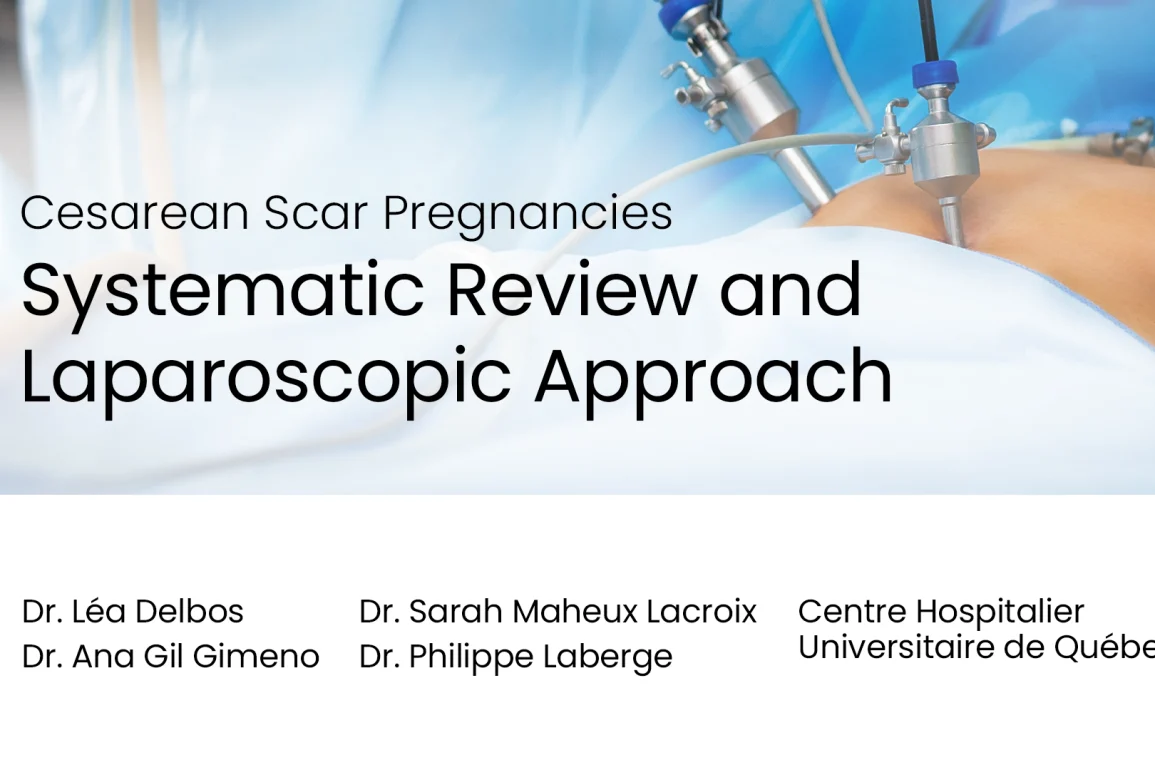Table of Contents
Video Description
This video briefly reviews options for management of cesarean scar pregnancies, and then demonstrates a technique for laparoscopic management.
Presented By




Affiliations
Centre Hospitalier Universitaire de Québec
See Also
Watch on YouTube
Click here to watch this video on YouTube.
What is Cesarean Scar Pregnancies: Systematic Review and Laparoscopic Approach?
Cesarean Scar Pregnancy (CSP) is a rare type of ectopic pregnancy implanted in the scar of a previous cesarean section. CSP is when a pregnancy implants within the scar tissue left by a previous cesarean delivery. It’s a rare condition, though increasing in occurrence due to rising cesarean delivery rates globally.
CSP can be hard to diagnose, often mistaken for other conditions like placenta previa or spontaneous abortion. Advanced imaging techniques, primarily transvaginal ultrasound and sometimes MRI, are used for diagnosis. The Laparoscopic approach:
- Method: A minimally invasive surgical procedure using a camera (laparoscope) and instruments through small incisions.
- Benefits: Potentially includes less blood loss, shorter hospital stay, quicker recovery, and less scarring compared to open surgery.
- Efficacy: Review of success rates of laparoscopic management of CSP.
What are the risks of Cesarean Scar Pregnancies: Systematic Review and Laparoscopic Approach?
Laparoscopic surgery often reduces these risks compared to open surgery. The success of laparoscopic procedures largely depends on the surgeon’s experience and skill, especially in a complex case like CSP. Risks may include:
- Hemorrhage: CSP can cause life-threatening bleeding.
- Uterine rupture: The pregnancy can cause the scar to rupture, endangering the mother and fetus.
- Impact on fertility: Complications from CSP might affect future fertility.
- Future pregnancies: CSP increases the risk of complications in subsequent pregnancies.
If complications occur during laparoscopic surgery, there may be a need to convert to an open procedure, which carries additional risks.
Video Transcript: Cesarean Scar Pregnancies : Systematic Review and Laparoscopic Approach
Because of the increase in caesarean deliveries, caesarean scar pregnancies have become more common in the last decades. Occurrence is one in 500 pregnancies among women with previous caesarean delivery and account for 4% of ectopic pregnancies. Many treatment options have been reported in the literature and we performed in 2017 a systematic review, to assess the efficiency and safety of treatment options for caesarean scar pregnancies.
We found that the overall success rate of systemic methotrexate and or local injection of methotrexate or potassium chloride was 62%. Dilation and curettage was associated with 28% risk of haemorrhage that dropped to 4% when combined with uterine artery embolisation. Hysteroscopic resection of CSP was successful in 88% of cases. However, these two surgical options are usually used for Type 1 CSP, namely when the gestational sac grows towards the uterine cavity.
Surgical options that allow for repair of the defect are laparoscopic, vaginal and open excision, which are associated with high success rate with low risk of haemorrhage. Laparoscopic approach appears to be a safe and reasonable option with potential benefits of minimally invasive surgery and could be associated with better outcomes during subsequent pregnancies.
This video demonstrates a technique of excision and repair of the CSP defect by laparoscopy and also shows some tips and tricks that will make the procedure easier and safe. This is a 31-year-old woman with no past medical or surgical history, except for low transverse caesarean section at term for her first child. She became pregnant ten months after her C-section and presented with first trimester bleeding.
CSP was diagnosed on transvaginal ultrasound by visualising the gestational sac and the myometrium at the scar site. The patient was initially treated with one systemic injection of methotrexate. Two months after the injection, HCG was negative, but the patient presented with persistent bleeding. On ultrasound, an outward bulge of the sac in the scar with little separation from the bladder was visualised and measured 23 per 20 mm.
A Type 2 CSP was diagnosed and hysteroscopic management was therefore judged inappropriate. We performed an excision of CSP and repair of the defect by laparoscopy. The following trocar sites were chosen. CSP was quickly identified with a typical outward bulge in the lower uterine segment.
A significant dissection of the bladder had to be performed in order to obtain a proper margin of repair. The bladder was densely attached to the CSP and carefully dissected down. Lateral dissection was performed to keep both ureters away. In order to maintain the surgical field clean and clear, cauterisation of bladder pillars with THUNDERBEAT combining bipolar and ultrasonic technology, was performed for a good haemostatis.
Malleable introduced into the anterior fornix facilitates the identification of the defect and dissection of the anterior vaginal wall. CSP dissection was initiated in the superior portion of the bulge with the active blade of THUNDERBEAT. The CSP was deeply implanted into the fibrous scar tissue of the lower uterine segment and a trophoblast was densely attached. A complete removal of CSP was performed.
Previous pregnancy termination with methotrexate likely reduced vascularisation of the CSP, allowing for easier haemostasis. An Endo Catch was used for tissue extraction. In order to perform a strong and safe suture, a Hegar dilator was inserted into the uterus and prevented overstitching in the posterior wall. To suture the defect, a V-Loc 0 was used to perform a full-thickness running suture by the two lateral ports, making suturing easier. Closing of the peritoneum was performed.
The patient was discharged from the hospital on post-operative day one and was well two months after surgery. Six months of contraception was recommended before the next pregnancy. Special thanks to Dr Fabien Simard from Sagamie Hospital for referring the patient.


